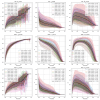Object Detection in Laparoscopic Surgery: A Comparative Study of Deep Learning Models on a Custom Endometriosis Dataset
- PMID: 40428247
- PMCID: PMC12110204
- DOI: 10.3390/diagnostics15101254
Object Detection in Laparoscopic Surgery: A Comparative Study of Deep Learning Models on a Custom Endometriosis Dataset
Abstract
Background: Laparoscopic surgery for endometriosis presents unique challenges due to the complexity of and variability in lesion appearances within the abdominal cavity. This study investigates the application of deep learning models for object detection in laparoscopic videos, aiming to assist surgeons in accurately identifying and localizing endometriosis lesions and related anatomical structures. A custom dataset was curated, comprising of 199 video sequences and 205,725 frames. Of these, 17,560 frames were meticulously annotated by medical professionals. The dataset includes object detection annotations for 10 object classes relevant to endometriosis, alongside segmentation masks for some classes. Methods: To address the object detection task, we evaluated the performance of two deep learning models-FasterRCNN and YOLOv9-under both stratified and non-stratified training scenarios. Results: The experimental results demonstrated that stratified training significantly reduced the risk of data leakage and improved model generalization. The best-performing FasterRCNN object detection model achieved a high average test precision of 0.9811 ± 0.0084, recall of 0.7083 ± 0.0807, and mAP50 (mean average precision at 50% overlap) of 0.8185 ± 0.0562 across all presented classes. Despite these successes, the study also highlights the challenges posed by the weak annotations and class imbalances in the dataset, which impacted overall model performances. Conclusions: In conclusion, this study provides valuable insights into the application of deep learning for enhancing laparoscopic surgical precision in endometriosis treatment. The findings underscore the importance of robust dataset curation and advanced training strategies in developing reliable AI-assisted tools for surgical interventions. The latter could potentially improve the guidance of surgical interventions and prevent blind spots occurring in difficult to reach abdominal regions. Future work will focus on refining the dataset and exploring more sophisticated model architectures to further improve detection accuracy.
Keywords: RCNN; deep learning; endometriosis; object detection.
Conflict of interest statement
Authors: Saman Noorzadeh, Giuseppe Giacomello, Filippo Ferrari and Nicolas Bourdel were employed by the company SurgAR. The remaining authors declare that the research was conducted in the absence of any commercial or financial relationships that could be construed as a potential conflict of interest.
Figures










Similar articles
-
Leveraging code-free deep learning for pill recognition in clinical settings: A multicenter, real-world study of performance across multiple platforms.Artif Intell Med. 2024 Apr;150:102844. doi: 10.1016/j.artmed.2024.102844. Epub 2024 Mar 13. Artif Intell Med. 2024. PMID: 38553153
-
Endoscapes, a critical view of safety and surgical scene segmentation dataset for laparoscopic cholecystectomy.Sci Data. 2025 Feb 25;12(1):331. doi: 10.1038/s41597-025-04642-4. Sci Data. 2025. PMID: 40000637 Free PMC article.
-
Deep learning-based intraoperative visual guidance model for ureter identification in laparoscopic sigmoidectomy.Surg Endosc. 2025 Jun;39(6):3610-3623. doi: 10.1007/s00464-025-11694-5. Epub 2025 Apr 22. Surg Endosc. 2025. PMID: 40263136
-
MAR-YOLOv9: A multi-dataset object detection method for agricultural fields based on YOLOv9.PLoS One. 2024 Oct 29;19(10):e0307643. doi: 10.1371/journal.pone.0307643. eCollection 2024. PLoS One. 2024. PMID: 39471150 Free PMC article.
-
Exploring the Role of Artificial Intelligence (AI)-Driven Training in Laparoscopic Suturing: A Systematic Review of Skills Mastery, Retention, and Clinical Performance in Surgical Education.Healthcare (Basel). 2025 Mar 6;13(5):571. doi: 10.3390/healthcare13050571. Healthcare (Basel). 2025. PMID: 40077133 Free PMC article. Review.
References
-
- Ghaderzadeh M., Shalchian A., Irajian G., Sadeghsalehi H., Zahedi bialvaei A., Sabet B. Artificial Intelligence in Drug Discovery and Development Against Antimicrobial Resistance: A Narrative Review. Iran. J. Med. Microbiol. 2024;18:135–147. doi: 10.30699/ijmm.18.3.135. - DOI
Grants and funding
LinkOut - more resources
Full Text Sources

